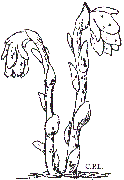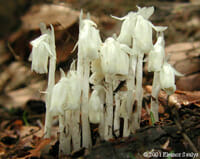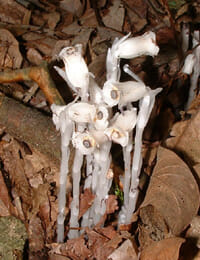 |
 |
 |
Identification & Description:
Indian pipe, has no chlorophyll, so it cannot obtain energy from sunlight. Instead, it gets nutrients from organic matter in the soil.
Indian Pipe, also known as “Corpse Plant,” is one of the easiest plants to recognize. Unlike most plants, Indian Pipe doesn’t have chlorophyll, the stuff that makes plants green. Indian Pipe is a waxy, whitish color. It turns black when it gets old.
Indian Pipe grows only four to ten inches tall. It has flowers that droop and tiny, scale-like leaves. When they look at it, most people think Indian Pipe is a fungus.
Indian Pipe is usually seen from June to September. It grows in shady woods with rich soil and decaying plant matter. This plant is often found near dead stumps.
Physical Characteristics
Perennial growing to 1.5m. . It is in flower from July to September. The flowers are hermaphrodite (have both male and female organs). We rate it 2 out of 5 for usefulness.
The plant prefers light (sandy), medium (loamy) and heavy (clay) soils. The plant prefers acid, neutral and basic (alkaline) soils. It can grow in full shade (deep woodland) or semi-shade (light woodland). It requires moist soil.
Indian Pipe has two special relationships; one with a tree, and one with a fungus. Actually, it’s one relationship, where Indian Pipe takes nutrients from both the tree and the fungus at the same time.
Here’s how it works: Since Indian Pipe has no chlorophyl, it can’t make its own food like most plants. Therefore, it has to “borrow” nutrients, either from decaying plant matter, or from another organism. The way it does this is by having its roots tap into the mycelia (root-like threads) of a fungus. The Indian Pipe can then take nutrients directly from the fungus. Meanwhile, the fungus itself has another relationship going on with a tree. The fungus’s mycelia also tap into the tree’s roots. Many fungi and trees have this type of relationship — it’s called a “mycorrhizal relationship.” The fungus gives nutrients to the tree and the tree gives nutrients to the fungus. Both organisms help each other out.
Indian Pipe, however, does not give anything back to the fungus or the tree. It takes nutrients from the fungus that the fungus had gotten for itself, and it also takes nutrients that the fungus had received from the tree. Since the fungus then has to take more nutrients from the tree, this makes Indian Pipe a parasite of both the fungus and the tree.
Characteristics
• Family: Indian-pipe (Monotropaceae)
• Habitat: woods, in leafy humus
• Height: 4-10 inches
• Flower size: 3/4 inch long
• Flower color: white
• Flowering time: June to September
• Origin: native
Edible Uses
Leaves.
The whole plant can be cooked. It is tasteless if eaten raw, but has a taste like asparagus when it is cooked.
Cultivation details
We have very little information on this plant but it should be hardy in this country. It is likely to require shady woodland conditions in a humus-rich moist soil,
It is a saprophytic plant, quite devoid of chlorophyll and depending totally on its host plant for nutrient.